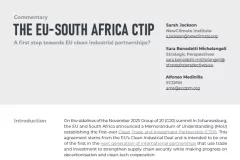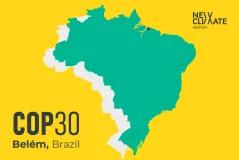Climate negotiators reconvene in Bonn for two weeks from 17th June 2019 to continue discussions on the details for the implementation of the Paris Agreement. An issue area that lacked consensus during the 2018 COP24 in Katowice, the nuts and bolts of Article 6 of the Paris Agreement, will be a major focus of negotiations at the upcoming session. Article 6 of the Paris Agreement establishes a framework that facilitates voluntary cooperation between countries in the implementation of their nationally determined contributions (NDCs) “to allow for higher ambition in countries’ mitigation and adaptation actions and to promote sustainable development and environmental integrity”. Cooperative approaches defined by Article 6.2 and the mechanism established by Article 6.4 are broadly understood to be the basis for new international carbon market mechanisms under the Paris Agreement.
Some stakeholders expect significant progress across several areas of the Article 6 negotiations in Bonn. Yet some fundamental issues remain which, if unaddressed, could risk undermining the Paris Agreement.
How can Article 6 promote ambition?
Under the Paris Agreement all countries have committed to pursue ambitious climate change mitigation actions and increase their ambition on a regular basis. Thus, under the Paris Agreement host countries will compromise their own ambition if they sell their emissions reductions to others without limitations. This situation is fundamentally different from the situation under the Kyoto Protocol, when the majority of countries had no reduction targets and could therefore sell their reduction units without consequences for their own targets.
Article 6 will promote increased ambition only if it exclusively targets “high-hanging fruit” mitigation options, that is, the technologies and measures which would otherwise remain inaccessible to host country governments’ own actions. The potential benefit of transferring an emissions reduction should always be weighed against the option of using those reductions for the country’s efforts towards its own NDC or future ratcheted NDCs. Therefore, potential host countries should use any low cost and easily accessible mitigation opportunities for their own mitigation commitments and/or receive support through other channels of finance for increasing future ambition. There is a risk that host countries would otherwise face perverse incentives to not increase the ambition of their NDCs in future cycles to include technologies and measures that they think might otherwise be eligible for Article 6 transactions.
This need to focus on high hanging fruit is a significant change from the Clean Development Mechanism (CDM), which was designed to increase cost-efficiency by providing flexibility and thus focused on low cost emissions reductions or “low-hanging fruit”. In contrast, providing flexibility or reducing costs are not mentioned as objectives in Article 6.
(How) should Kyoto mechanisms (the CDM) be transitioned into Article 6 mechanisms?
If Article 6 is to exclusively focus on the “high-hanging fruit”, which it must do in order to avoid undermining ambition in the Paris Agreement, then policy makers should be very cautious when considering any transition of the CDM to the post-2020 world. Very few, if any, of the 8,000+ projects registered under the CDM are technologies or measures that are truly inaccessible to host country governments today. Aside from this more fundamental incompatibility, there is also the significant risk that the transfer of CDM projects into Article 6 mechanisms would significantly reduce the mitigation impact of Paris pledges. NDCs and their reference scenarios already take into account all climate actions up to that point, including emission reductions from CDM projects. Evaluation of the status of existing CDM projects shows that the vast majority continue their abatement activity anyway, even in the continued absence of revenues for certified emission reduction credits (CERs). Already existing CDM projects could potentially supply up to 4.65 billion new CERs from the period 2013 - 2020, of which 3.8 billion have marginal costs mostly at a price of below EUR 1 per CER due to sunk investments cost. To put it into context, if such a transfer were allowed, a country like Germany could hypothetically purchase all these credits for 3.8 billion EUR and claim to be entirely carbon neutral for four years without any new emission reductions on the global level.
The clearest way to safeguard the ambition of the Paris Agreement would be to not allow the transition of any existing project or credits. A compromise would be to restrict transition eligibility to projects based on their vulnerability to discontinue GHG abatement: this would still have negative implications for the ambition of NDCs, but the volume of empty credits would be significantly less damaging. This could, however, still set a dangerous precedent for the eligibility of specific project types which cannot be considered a “high-hanging fruit”. Alternatively, existing projects should reapply for acceptance under Article 6 and prove their additionality against countries’ NDCs and the ambition of the Paris Agreement as a whole.
What type of credits should be eligible for use by CORSIA?
Strong rules under the Paris Agreement will also affect the contribution of international aviation via its CORSIA scheme. Our recent research finds that without restrictions on offset eligibility, the supply potential from the 8,000+ registered CDM projects alone exceeds the demand from CORSIA, which is estimated to reach between 1.6–3.7 billion tCO2 over the scheme’s operational period from 2021 to 2035. Most of these projects would continue to exist and reduce emissions with or without CORSIA. For CORSIA to compensate global aviation emissions, eligible credits should be limited to new projects under Article 6, based on high-hanging fruit technologies and measures that are otherwise inaccessible to host countries.
Should activities outside the scope of an NDC be allowed under Article 6?
Crediting outside the scope of NDCs risks setting a perverse incentive to not expand the scope of NDCs that do not yet cover economy wide emissions. This potential perverse incentive can be reversed if the expression of a target with an economy-wide scope is made a precondition for Parties to engage in Article 6 transactions, in which case a discussion on this scope differentiation becomes obsolete.
How can the requirement to contribute to an ‘Overall Mitigation of Global Emissions’ (OMGE) be operationalised?
The requirement for urgent and ambitious action in all areas calls for tools that go beyond providing flexibility but directly deliver a contribution to lowering global GHG emissions. Negotiators in Paris understood this urgency and included the requirement for OMGE also in the Agreement's text on Article 6.4. The text is simple and specifies that the mechanism “shall aim to (...) deliver an overall mitigation in global emissions”. Several criteria need to be fulfilled to ensure overall mitigation: these include quantification, accounting and mandatory application. These criteria can be effectively and efficiently fulfilled when emission reductions which aim to contribute to OMGE are treated the same as reductions that are up for transfers which will need to be monitored, reported and verified (MRV) with high scrutiny and issued into a registry.
A real reduction can be achieved by transferring only part of the generated credits and not using the remaining reductions towards any other target. Units can be discounted and cancelled at initial issuance of emission reduction units or for the first transfer of emission reduction units to the host Party. Such automatic cancellation of credits is the only possible way that OMGE can be operationalized in a meaningful way that guarantees achievement of the objective. Other options discussed and described in draft negotiation texts do not have the ability to ensure overall mitigation since one or several of the criteria are not met.
Under a large range of circumstances, abatement is enhanced in both host and acquiring countries if rules are set to ensure real reductions (contributions to OMGE). Although it may not be immediately intuitive, more projects are implemented in host countries with such rules. This is enabled through higher credit prices which outweigh the effect that projects receive fewer credits for their emission reductions. Such rules would only lead to fewer projects if the OMGE rate is set very high (e.g. above 50%) or if the demand is very elastic, which is unlikely to be the case.
Should there be a levy to finance adaptation and an overall climate benefit for all types of international carbon markets, or just some?
Including a levy on international trades to finance adaptation (share of proceeds, SOP) was a contentious issue in Katowice. The Paris Agreement includes such a levy on parts of the mechanisms (Article 6.4) but not on other parts (Article 6.2). The world is already suffering from the effects of climate change and especially developing countries need further adaptation finance – an SOP from both Article 6.4 and 6.2 is an innovative source of finance and in the interest of developing countries to continue the good work being done under the Adaptation Fund. Agreeing on an SOP and an OMGE contribution brings a double benefit for climate action by supporting both adaptation and mitigation. Moreover, limiting such a levy (SOP) and a contribution to overall mitigation of global emissions (OMGE) to Article 6.4 only creates a risk of an imbalanced regulation to the detriment of Article 6.4 (and the environment!).
How should sustainable development benefits be addressed in Article 6?
Based on the CDM experience, only reporting sustainable development benefits is problematic for future carbon markets. Counter to the CDMs claims, contributions to host countries’ sustainable development priorities have been modest at best. Its numerous design related challenges, including difficulties in operationalising the term in some countries, unspecific requirements for identifying and reporting benefits and risks, little monitoring and no ex-post checks, were all significant reasons for this. It is essential to agree on some form of monitoring and ex-post checks for sustainable development contributions to ensure the integrity of Article 6 mechanism/s. Moreover, beyond (and before) discussing benefits, Article 6 needs to clearly articulate “do no harm” as a key principle for its operation. Negative impacts of CDM projects, including human rights abuses, have been reported in the absence of specific language under CDM’s rules to avoid/minimise harms from projects in its modalities and procedures. Moreover, in line with the progress made under REDD+, voluntary markets and climate finance channels such as UNDP, GCF, Adaptation Fund – Article 6 negotiators must rise beyond differences and engage in a constructive dialogue to explore safeguards under Article 6.
Fundamentally, the discussion on benefits and safeguards needs to be aligned with the Sustainable Development Goal (SDG) framework. The universally agreed SDGs provide a common, agreed template to operationalise contributions to sustainable development under Article 6. Actors outside the UNFCCC process are already working on translating the macro-level SDG targets into actionable and monitorable indicators. However, vague rule setting on sustainable development under Article 6 risks creating a missed opportunity.
Getting it right
In sum, the Paris Agreement’s Article 6 represents a fundamental shift in the role of international carbon markets in the global effort to address the climate crisis. Careful rule setting is essential to make sure they contribute to the solution as opposed to being reduced to a tool for greenwashing a lack of effort to reduce emissions. Achieving the overall temperature targets of the Paris Agreement require “rapid, far-reaching and unprecedented changes in all aspects of society” not fuzzy accounting and a cheap get out of jail free card. Decisions in Bonn and Santiago this year will have profound and long-lasting consequences – negotiators who care about the climate don’t have much room for compromise.






